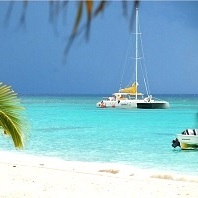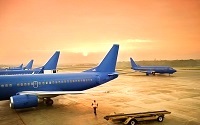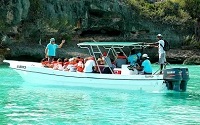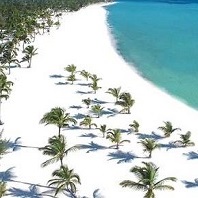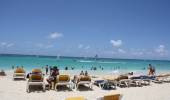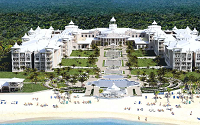The History of Punta Cana
Forty years ago, Punta Cana was almost unheard of, a far cry from the famous beach destinations it has become today.
Foreign Investments ...

 Old airstrip Punta Cana
This transition began when,
in 1969, a group of American investors bought 30 square miles (77 km2) of undeveloped Dominican land straddling 5 miles of the
nation's east coast. At the time, this land was no more than thick, forbidding jungle without any access roads; the only signs of
human life were a few fishing villages along the coast. The savvy investors saw the beaches, however, and their white sand,
coconut palms, crystal clear waters, and lush coral reefs.
Old airstrip Punta Cana
This transition began when,
in 1969, a group of American investors bought 30 square miles (77 km2) of undeveloped Dominican land straddling 5 miles of the
nation's east coast. At the time, this land was no more than thick, forbidding jungle without any access roads; the only signs of
human life were a few fishing villages along the coast. The savvy investors saw the beaches, however, and their white sand,
coconut palms, crystal clear waters, and lush coral reefs.
Punta Cana History
| 1969: | Americans start to purchase land in Punta Cana |
| 1971: | First hotel built in Punta Cana |
| 1978: | Club Med builds its first large resort |
| 1984: | Commercial Airport is opened in Punta Cana |
The first hotel ...
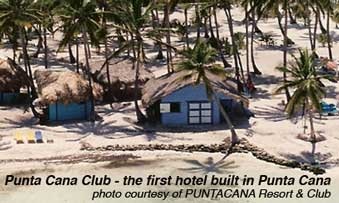
 Old image of Punta Cana Club
Wisely changing the name of the land from Punta Borrachon ('Drunken Point'), the investors called the land Punta Cana, after the
Punta Cana Club, a local hotel. Punta Cana soon began to attract attention from the rest of the world. Dominican fashion designer
Oscar de la Renta and international music artist Julio Iglesias were among the famous early guests and investors.
Old image of Punta Cana Club
Wisely changing the name of the land from Punta Borrachon ('Drunken Point'), the investors called the land Punta Cana, after the
Punta Cana Club, a local hotel. Punta Cana soon began to attract attention from the rest of the world. Dominican fashion designer
Oscar de la Renta and international music artist Julio Iglesias were among the famous early guests and investors.
In 1971 the first hotel, with room for 40 guests and 10 cabins, was built within Punta Cana itself. The access to the hotel was limited to a dirt airstrip, allowing only small planes. The initiative got noticed locally and oversees; with this tourism in Punta Cana took off.
Club Med ...
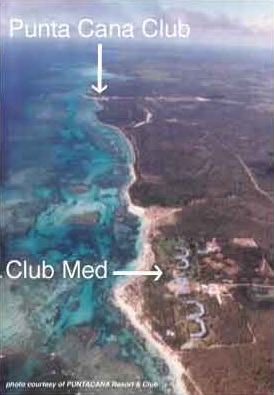
 First development Club Med
First development Club Med
By 1978 the French resort chain Club Med had constructed a 350 room Club Med Punta Cana, but at that time the area was still fairly wild. Toothpaste company Colgate finally stepped in and connected the area by road to the rest of the island, reducing travel time into the area from 6 hours down to half an hour (from the nearest town). The area continued to grow, and in 1982, the owners of the Punta Cana resort received permission from the Dominican government to build a proper commercial airstrip, which was opened in 1984.
Improvements of infrastructure..
The area is still somewhat remote, but during the years that followed fast improvement to the road network were made. In 2012 the new Coral highway has opened and it connects Punta Cana with the rest of the island. Instead of 6 hours, it now only takes 30 minutes for the trip to the town of Higuey.
The new airport...
In 1982, after years of negotiation and going back and forth, the Dominican government gave permission to the owners of the Punta Cana Resort to build a real airport, so that bigger planes could land.
By 1984 the first real airport was operational. Thereafter, the number of annual visitors grew rapidly from 2,976 passengers to almost 2.4 million people 30 years later. Many of these visitors are loyal fans who have been coming back for years, drawn back by an incredible beach vacation in one of the luxury resorts along the coast. Currently there are over 60 resorts, stretched along a strip of 30 miles of beautiful beaches.
The economic backbone of the country...
These resorts, along with the different businesses which have flourished due to the onset of tourism, have become the backbone of the local economy. It is worthwhile to note that today approximately a quarter of the country's GDP is made in Punta Cana. The initial investors couldn't have dreamt that the area would become so important for the entire country.
© The images in this article are courtesy of Punta Cana Resort & Club.
The History of the Dominican Republic
| Year | Historical Event |
|---|---|
| 1492: | Christopher Columbus lands on Hispaniola Island |
| 1496: | Santo Domingo becomes the first capital of the first Spanish colony in the Western hemisphere |
| 1515: | Gold supplies are depleted, Spaniards move on to Mexico |
| 1697: | The western part of the island is seized by the French |
| 1791: | The slaves in the French quarter revolt, and in1804 they declare independence from France |
| 1809: | Eastern part of the island returns to Spanish control |
| 1844: | This section names itself the Dominican Republic, and declares independence from Spain |
| 1930: | General Trujillo establishes a dictatorship |
| 1937: | Army massacres about 20,000 Haitians living near the border |
| 1961: | Trujillo is assassinated, followed by the first democratic election for a new president |
| 1966: | Trujillo's protege remains in power for the next 5 re-elections. |
| 1979: | Two hurricanes leave 200 thousand people homeless |

